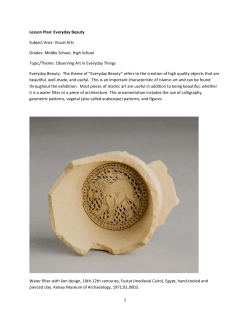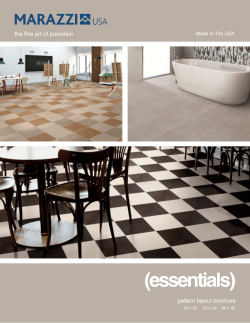
Name: Hour: Artists and craftsmen have created
Name: Hour: Artists and craftsmen have created ceramic tiles for over 4000 years! Ceramic tiles are both durable and functional, making them an excellent choice for the interior and exterior of buildings. Examples of ceramic tile have been found in some of the oldest known structures, including the pyramids, and the ruins of ancient Greek cities! Decorative tile work probably originated in the near east. The elaborate patterns help make up for the lack of visual interest in the desert. Islamic Art Friday Mosque at Herat in Afghanistan Islam is the religion practiced by an ethnically diverse group of Muslims all over the world. It is based on the belief that Allah is the one, and only, Supreme Being. For Muslims, Islam is more than just a religion; it is a way of life and a source of political and cultural beliefs. Islam began with the prophet Muhammad around 622. Although unpopular at first, Muhammad eventually attracted many followers. Today, one fifth of the world’s population believes in Islam! Islamic art is highly detailed and elaborate. It is characterized by intricate geometric patterns that are frequently combined with ornate calligraphy. In addition to being found in architectural decoration, Islamic designs adorn furniture, tapestries, rugs/carpets, ceramic containers, and more. The Muslim belief that Allah is unique and cannot be represented with a man or animal means that human figures are absent from Islamic artwork. Instead, Muslim artists are expert pattern makers! Mihrab (prayer niche) in Isfahan, Iran, 1354-1355 Tile fragment from Central Asia, 14th Century Created by S. Wagner-Marx Tile Design 1. The geometric patterns in Islamic art are very complex. Shapes are combined, interlaced, and duplicated to create unified and ordered designs. Your first task for this assignment is to design a tile using geometric lines and shapes. Have the following guidelines in mind when planning out your design. • • • • What elements of your design will be repeated? How can you incorporate symmetry into your design? What geometric shapes will you use? Will you include a pattern? Design Vocabulary Form: 3-D object or artwork that can be viewed from all angles Symmetry: type of balance when two halves of a design are identical Repetition: design element that occurs more than once, helps achieve unity Pattern: regularly repeating decorative design Texture: surface treatment, or how an object feels Geometric Shape: shapes with regular contours, and straight edges such as squares, triangles, or circles Unity: Organization of design so all parts contribute to a coherent whole Use the following boxes to plan 3 possible designs for your Islamic inspired tile: 2. Next, transfer and enlarge your best design to a square piece of drawing paper (this will be precut for you and will become the template for the sides of your box). 3. Roll out a slab of clay. Use guide rails to maintain uniform thickness. Carefully trace your square piece of paper and cut out your tile with a needle tool. Mosaic Glazed Tile, late 15th century, Iran 4. Use clay tools to incise, or carve, your design from the surface of your tile. How might you add texture to your tile? Created by S. Wagner-Marx Constructing the Box The tile you designed and created needs to dry and become greenware so it can be bisque fired. That tile will be used as a press mold to make the sides of your box! To build your box, follow the steps listed here! 1. Roll out a slab of clay using the same technique you used when making your tile. Use your square template to cut out 5 squares. If you would like to put a cover on your box, cut out a 6th square. Use your press mold to “stamp” your design onto all but one of your squares. Ceramics Vocabulary Clay: decomposed rock Slab: rolling out a sheet of clay with even thickness Coil: using one’s hands to roll clay into a snakelike shape Score & Slip: scratching into clay and applying watered down clay like glue to attach two pieces of clay Wedging: kneading clay to release air bubbles Appliqué: clay decoration that is added on Press Mold: a form that clay can be pressed into, or a form that can be pressed into clay Greenware: clay that has dried completely and is ready to be bisque fired (sometimes called bone dry) Leather hard: clay that is stiff, but can still be worked with and carved into Bisqueware: clay that has been fired once Kiln: oven used to “fire” clay and make it permanent 2. Carefully lay your slab pieces onto a piece of plastic board and cover loosely with a plastic bag. Your clay needs to become leather hard and will need to dry out a bit. When slabs become leather hard they are stronger and much easier to assemble. • It is VERY important that you do not let your clay dry out completely and become greenware! You will NOT be able to work with it and will have to begin again. Arabesque-style decoration at the Great Mosque of Cordoba Arabesque is characterized by stylized twisting plantlike designs. Created by S. Wagner-Marx 3. To assemble your slab pieces, you will need to first score the edges that you are going to join in a crosshatching pattern. Apply slip to the scored marks and carefully join the two slabs. Use even pressure with your fingers to create a nice seal. You want to avoid trapping air in the seam! 4. Roll a small coil with your fingers. Smooth the coil into the inside seam you just created in step 3 to strengthen it. Check the outside corner. Will you need to add a small coil to create a smooth edge? 5. Continue joining the slab pieces until the box is complete. If you would like, add feet to the base of your box and an appliquéd handle to the lid. Your artwork is now ready to become greenware and be bisque fired. 6. Your last step is to decorate your tile box. We will be using colored underglazes and clear overglaze to create colorful accents on your tile designs! Created by S. Wagner-Marx
© Copyright 2025





















